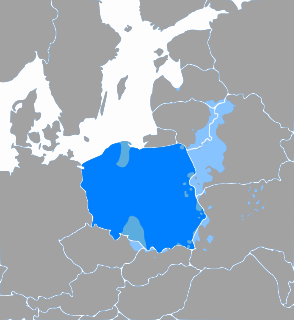
The Media of Poland consist of several different types of communications media including television, radio, cinema, newspapers, magazines, and Internet. During the communist regime in Poland the Stalinist press doctrine dominated and controlled Polish media. The country instituted freedom of press since the fall of communism. The Polish media system's main features are the product of the country's socio-political and economic post-communist transition. These features include: the privatisation of the press sector; the transformation of the state radio and television into public broadcasting services; influx of foreign capital into the media market and European integration of audiovisual media policies. Today the media landscape is very plural but highly polarized along political and ideological divides.

The BBC World Service, the world's largest international broadcaster, broadcasts radio and television news, speech and discussions in more than 40 languages to many parts of the world on analogue and digital shortwave platforms, Internet streaming, podcasting, satellite, DAB, FM and MW relays. In November 2016 the BBC announced again that it would start broadcasting in additional languages including Amharic and Igbo, in its biggest expansion since the 1940s. In 2015 World Service reached an average of 210 million people a week. The English-language service broadcasts 24 hours a day.

Digital audio broadcasting (DAB) is a digital radio standard for broadcasting digital audio radio services, used in many countries around the world, though not North America.
There are two types of radio network currently in use around the world: the one-to-many broadcast network commonly used for public information and mass-media entertainment, and the two-way radio type used more commonly for public safety and public services such as police, fire, taxicabs, and delivery services. Cell phones are able to send and receive simultaneously by using two different frequencies at the same time. Many of the same components and much of the same basic technology applies to all three.
In-band on-channel (IBOC) is a hybrid method of transmitting digital radio and analog radio broadcast signals simultaneously on the same frequency.

Digital Radio Mondiale is a set of digital audio broadcasting technologies designed to work over the bands currently used for analogue radio broadcasting including AM broadcasting, particularly shortwave, and FM broadcasting. DRM is more spectrally efficient than AM and FM, allowing more stations, at higher quality, into a given amount of bandwidth, using various MPEG-4 audio coding formats.
The Voice of Russia, commonly abbreviated VOR, was the Russian government's international radio broadcasting service from 1993 until 2014, when it was reorganised as Radio Sputnik. Its interval signal was a chime version of 'Majestic' chorus from the Great Gate of Kiev portion of Pictures at an Exhibition by Mussorgsky.

Polskie Radio Spółka Akcyjna is Poland's state-owned national public-service radio broadcasting organization.

Jazz FM, is a radio station broadcasting on digital radio in the United Kingdom and Malta which predominantly plays jazz music, jazz standards as well as blues and soul music. The station also plays specialist programming in a wide variety of jazz disciplines. The station, in this incarnation set up by Richard Wheatly, can trace its roots back to 102.2 Jazz FM, which launched in 1990. The current station launched on 6 October 2008 at 19:00 BST.
Digital Audio Broadcasting in Ireland is one form of digital radio transmission in the state. It was launched to the public on 30 November 2006, with trials taking place in 1998, 2001 and 2006. Currently, 56% of Ireland's population - mainly in Counties Cork, Limerick and the North East - can receive permanent DAB services. Geographic coverage on a portable or car radio is much less. In contrast, all the RTE stations on the DAB multiplex are also available nationwide via Saorsat and about 99% geographic coverage is possible via DVB. Generic DVB receivers do need mains, but are typically cheaper than DAB radios. Many portable DAB radio sets have 1/10th to 1/50th of the running time of an AM/FM set, typically giving only 6 hours use. There are also in-dash DVB Terrestrial receivers for cars, though it's illegal for the driver to watch the TV channels.

Radio România Internaţional is a Romanian radio station owned by the Romanian public radio broadcaster Societatea Română de Radiodifuziune that broadcasts abroad. Prior to 1989, the station was known as Radio Bucharest.
The Motorola E770 mobile phone is a 3G phone that operates primarily on the third generation phone network; however, it can be downscable to GPRS 2.5 and below if required.
Ukrainian Radio is the publicly funded radio broadcaster in Ukraine since 1924. In 2017 has been merged with national TV company into country's national broadcaster UA:PBC. Until the creation of the National Public Broadcasting Company of Ukraine in 2015 the National Radio Company of Ukraine was an independent company.
Radio "Belarus" is the official international broadcasting station of Belarus. It has been announced that the station will cease broadcasting on shortwave, mediumwave, and longwave as of 1 April 2016.
Polskie Radio Program IV, known also as PR4 or radiowa Czwórka is a radio channel broadcast by the Polish public broadcaster, Polskie Radio.
Historically, Białystok has been a destination for internal and foreign immigration, especially from Central and Eastern Europe. In addition to the Polish minority, there was a significant Jewish majority in Białystok. According to Russian census of 1897, out of the total population of 66,000, Jews constituted 41,900. World War II changed all of this, in 1939, ca. 107,000 persons lived in Białystok, but in 1946 – only 56,759, and to this day there is much less ethnic diversity than in the previous 300 years of the city's history. Currently the city's population is 97% Polish, 2.5% Belarusian and 0.5% of a number of minorities including Russians, Lipka Tartars, Ukrainians and Romani. Most of the modern day population growth is based on internal migration and urbanization.
Polskie Radio 24 - news radio station established by Polskie Radio, Polish national state-run radio broadcaster.



















